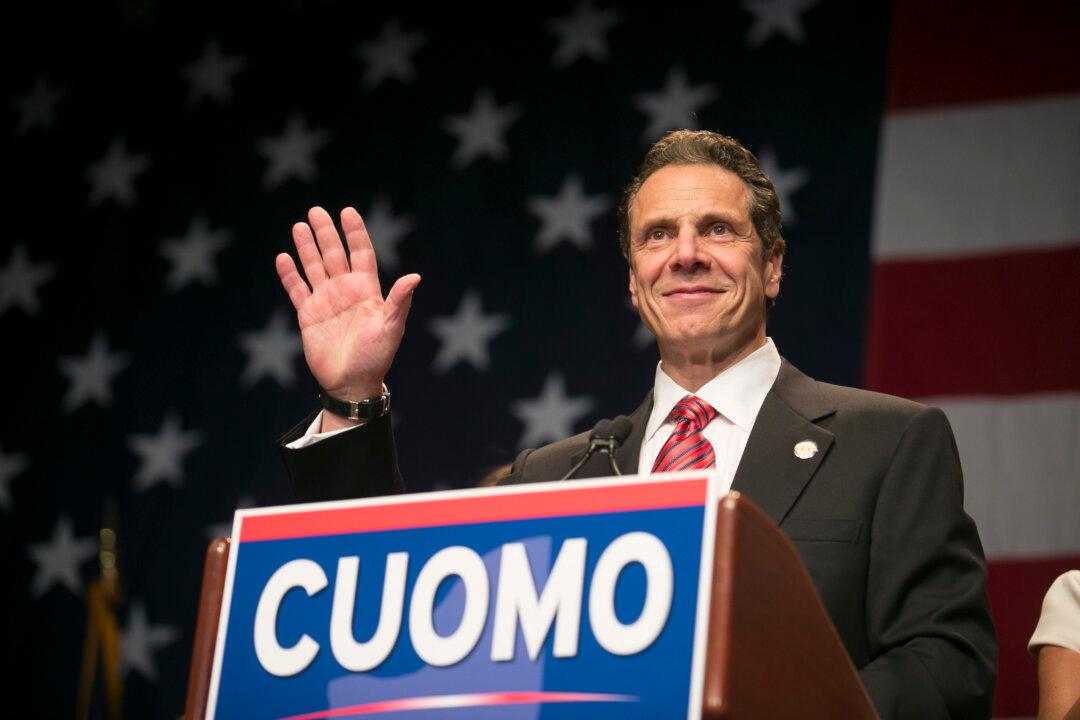NEW YORK—A win for the Democrats was expected. The uncertain part of the equation was by how much they would win.
Democrats swept up the four key positions Tuesday in New York government. Cuomo took governor, his running mate Kathy Hochul won lieutenant governor, and Thomas DiNapoli and Eric Schneiderman snatched up comptroller and attorney general, respectively.
Schneiderman faced off with Republican John P. Cahill, who challenged his handling of climate change issues.
Cuomo is the first Democrat governor to win a second term since his father, Mario Cuomo. He crushed his Republican opponent Westchester County Executive Rob Astorino, holding 58 percent of the vote with 35 percent of the votes recorded.
Cuomo is believed to harbor national ambitions and has been mentioned as a possible presidential candidate, though he has said he intends to serve a full four-year term.
At the combined election party for the four Democratic Party standard bearers at the Sheraton New York Times Square Hotel, Mayor Bill de Blasio took the stage first Tuesday night to declare the win.
Wearing a blue tie, he announced, “It was loud and clear that ultraconservatives, tea party conservatives, were never going to win New York state.”
The four wins mean a lot more progress on big liberal issues, such as immigration reform, women’s equality, and minimum wage, said the mayor, who had said earlier in the day that he and Cuomo shared the same vision.
Heading Left
While Democrats in solidly blue states like Illinois, Massachusetts, and Connecticut all faced formidable challenges for governor from Republicans, Cuomo was able to win handily by appealing to a wide range of voters with his socially liberal, fiscally conservative record.
To secure the victory, however, Cuomo had to rally his base. He uttered rhetoric Monday about the “collective” and getting everyone and their neighbors to vote, a far cry from the days he criticized his Democratic primary challenger Zephyr Teachout for being too progressive.
And despite a hasty return to the campaign following an Ebola case in New York and adjusting a controversial quarantine policy, Cuomo managed to come out on top.
His win was assured by lopsided margins in lower-income communities and among minorities and women—the base of the Democratic Party. In the day leading up to the election, Cuomo and Hochul were joined by Schneiderman and DiNapoli in courting these demographics.
Cuomo rocked the city, Long Island, and the Hudson Valley, while Astorino found his strength in the suburbs.
Astorino earned the support of conservatives and split whites, but there were more Democrats in New York than he could win over.
Troubled Economy
Astorino ran a classically conservative campaign in a blue state by offering New Yorkers lower taxes. Cuomo, by contrast, Astorino has said, hasn’t done enough for New York’s economy.
The worry Astorino was addressing is reflected in polls, which said that two in five New Yorkers are worried about the state economy.
Astorino had also tried to appeal to liberals by increasing welfare services in Westchester County, where he was chief executive.
In a final push on the eve of and the hours before Election Day, he and his team went around the city’s five boroughs, showing his usual wide-ranging campaigning. He was the first since gubernatorial candidate Franklin Delano Roosevelt to campaign in all 62 counties, according to his press office.
But Cuomo was much better funded than Astorino, enjoying an almost 10-to-1 ratio in fundraising, including a million from real estate developer Leonard Litwin.
“I just got off the phone with Rob Astorino who called to congratulate us,” said Cuomo as he took the stage Tuesday in front of supporters. He reminded the crowd of his accomplishments and promised progress on a litany of Democratic issues, while throwing in a bone for cutting property taxes.
He thanked his base, repeating that it was one unified state more than three times.
The 56-year-old Cuomo will begin his second term with a long list of challenges, including the implementation of a new medical marijuana law, a decision on whether to allow fracking for natural gas, and the selection of up to four new casino operators upstate.
Ending the night with a tribute, Cuomo welcomed his father onto the stage, calling him the father of the modern Democratic Party.
The Associated Press contributed to this report.




